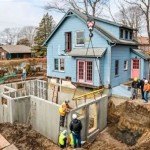Floor Drain In Basement Backing Up: A Comprehensive Guide
A floor drain in the basement is a crucial plumbing fixture that allows water to flow away from your home. However, like any other plumbing component, it can sometimes malfunction, leading to a backup. In this article, we will explore the essential aspects of floor drain backup and provide a comprehensive guide to resolving this issue.
Causes of Floor Drain Backup
Understanding the causes of a floor drain backup can help you prevent future occurrences. Here are some common reasons:
- Clogs: Hair, soap scum, dirt, and other debris can accumulate in the floor drain, blocking the flow of water.
- Grease Buildup: Fats, oils, and grease from cooking can solidify in the drain, creating a barrier to water flow.
- Root Intrusion: Tree roots can penetrate pipes and cause cracks or blockages in the drain line.
- Collapsed or Cracked Pipes: Underground pipes can deteriorate over time, leading to collapses or cracks that allow water to leak out.
Signs of Floor Drain Backup
Recognizing the signs of a floor drain backup is essential for timely intervention. Look out for these indications:
- Slow Drainage: Water takes longer than usual to drain from the floor.
- Gurgling Sounds: Air bubbles and gurgling noises coming from the drain may indicate a blockage. li>Foul Odor: A persistent foul odor coming from the floor drain suggests organic matter buildup or a sewer gas leak.
- Water Pooling: Standing water around the floor drain indicates a severe backup.
How to Fix a Floor Drain Backup
Depending on the cause of the backup, there are several methods to resolve the issue:
1. Clear Clogs- Use a drain snake or auger to physically remove debris from the drain.
- Apply a chemical drain cleaner specifically designed for floor drains.
- Pour boiling water down the drain to dissolve grease buildup.
- Avoid pouring grease or fats down the drain.
- Use a commercial grease trap to collect and dispose of cooking grease.
- Regularly pour hot water and dish soap down the drain to break down grease.
- Plant trees away from underground drain lines.
- Inspect and trim tree roots that may be near pipes.
- Consider using root barriers or chemical treatments to prevent root growth.
- Contact a licensed plumber to inspect and repair collapsed or cracked pipes.
- Consider replacing old or damaged pipes with more durable materials.
- Maintain proper drainage and prevent clogs to reduce strain on the pipes.
Preventive Measures:
- Install a drain cover or strainer to prevent hair and debris from entering the drain.
- Regularly pour a cup of baking soda followed by a cup of vinegar down the drain to neutralize odors and break down buildup.
- Clean the floor drain thoroughly once or twice a year to remove any accumulated gunk.
Conclusion
A floor drain in the basement is an essential part of your plumbing system, preventing water from accumulating in the lowest level of your home. If you encounter a floor drain backup, it's important to promptly identify the cause and take appropriate action. By addressing the issue promptly and implementing preventive measures, you can ensure the smooth functioning of your floor drain and protect your basement from water damage.

Why Does My Floor Drain Back Up Structure Tech Home Inspections

Basement Drain Backing Up Here S What To Do Right Now Servicemaster

Basement Drain Backing Up In Winter Top Causes Solutions

Why Is My Floor Drain Backing Up Code Blue Plumbing

How To Install A Floor Drain Backflow Preventer Family Handyman

How Do You Unclog A Basement Floor Drain Atlanta Ga Plumbers

Basement Drain Backing Up Here S What To Do

How To Fix Basement Floor Drain Backing Up Avalon Home Inspections

Basement Drain Back Up 1 Minute Of Cause Cures Youtube

How To Unclog A Basement Floor Drain Complete Diy Guide








